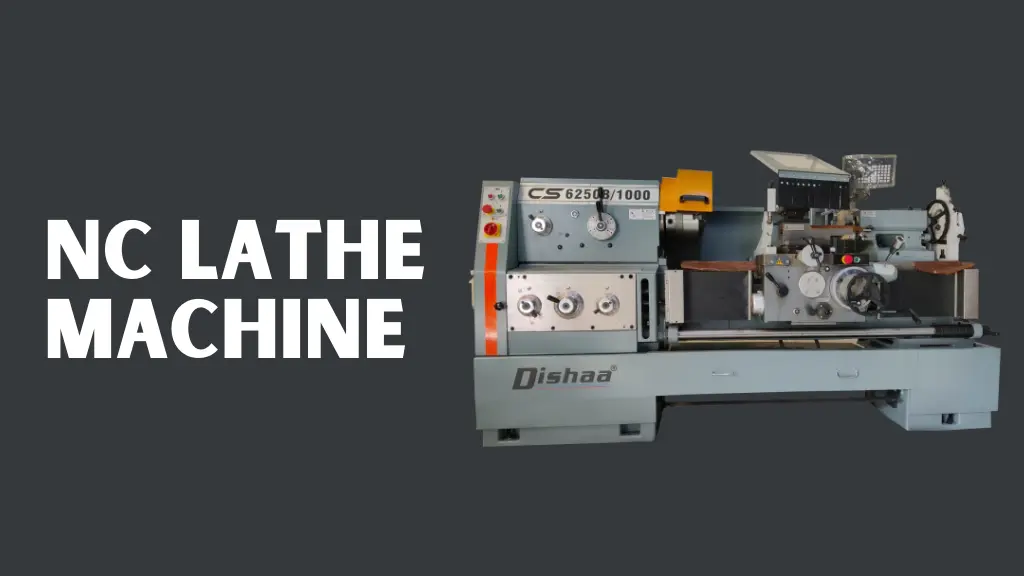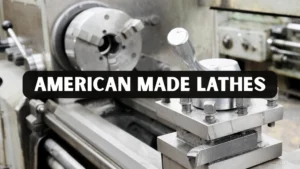In modern manufacturing, precision and efficiency are vital for achieving consistent results. One machine that has significantly shaped this progress is the NC Lathe. Short for Numerical Control Lathe, it combines mechanical design with automated control to produce highly accurate and repeatable components. Professionals, workshop owners, and students benefit from knowing how it works and the impact it has on improving productivity and product quality.
This guide draws on expert insights, real-world applications, and trusted industry references to explore these machines in depth. It covers their working principles, different types, benefits, and practical applications, along with essential maintenance practices. By the end, you’ll gain a clear and trustworthy understanding of why they remain a cornerstone of modern machining and continue to set the standard for high-quality manufacturing.
What is an NC Lathe?
An NC Lathe is a machine tool designed to rotate a workpiece while cutting tools shape it according to programmed instructions. Unlike traditional lathes that require manual control, it operates through an automated controller, ensuring high precision and repeatability. This level of consistency is especially valuable in industries where mass production and accuracy are essential.
The machine is built from key components that work together to achieve accuracy. The spindle rotates the workpiece at controlled speeds, while the tool turret holds multiple tools for sequential operations. The bed provides a stable base and guides movement, and the controller manages speed, feed, and positioning. For longer parts, the tailstock adds support, allowing the lathe to produce complex shapes efficiently and with minimal error.
How It Works
The process of these machines relies on programmed instructions that are converted into precise mechanical movements. Operators use G-code or M-code to define tool paths, spindle speeds, feed rates, and cutting depths, ensuring accuracy throughout the operation. This programming step is crucial because it sets the foundation for consistent and repeatable results.
Once the part design is created through CAD or CAM software, the workpiece is secured in the spindle and the cutting tools are loaded into the turret. The program then executes automatically, allowing the machine to perform turning, threading, drilling, or grooving operations with minimal manual input. Each step is carefully monitored to maintain quality standards and reduce the possibility of errors.
In practical use, the benefits of an NC Lathe are supported by industry evidence. For instance, an automotive workshop reported a 30 percent decrease in production errors along with a 25 percent increase in overall output after adopting this technology. This demonstrates how automation, backed by proper programming and expertise, directly improves efficiency and product quality.
Types of NC Machines
Choosing the right machine depends on production requirements and the complexity of the part being manufactured. Manual models offer partial automation combined with manual control, allowing operators to adjust speed, tool positions, or minor corrections. These machines are commonly used in small workshops or training environments where flexibility and hands-on learning are priorities.
Fully automated options, often referred to as CNC lathes, carry out the machining process with minimal human involvement. Operators mainly monitor operations, which reduces labor costs and ensures consistent results. Turret-style models, equipped with a rotating turret that holds multiple tools, further enhance productivity by allowing rapid tool changes during medium or high-volume production runs.
For specialized applications, Swiss-type models are highly valued in industries such as electronics, aerospace, and medical manufacturing. Their sliding headstock provides superior stability for slender workpieces, ensuring unmatched precision. On the other hand, compact machines are designed to be space-efficient without sacrificing accuracy, making them ideal for small-scale workshops. By selecting the right NC Lathe, manufacturers can align capabilities with production goals, achieving both efficiency and quality.
Advantages for Manufacturers
The advantages of adopting advanced machining technology are substantial. Automation minimizes the likelihood of human error, resulting in consistently accurate cuts and reduced material waste. At the same time, faster operational speeds drive higher productivity, enabling manufacturers to meet greater demand with fewer labor requirements.
A numerical control lathe also provides impressive versatility by performing multiple operations such as turning, threading, drilling, and grooving. This makes it an asset for projects that require precision and consistency, particularly in mass production environments. Additionally, automation enhances workplace safety since operators have less direct exposure to cutting tools, significantly lowering accident risks.
Real-world performance backs up these benefits. An aerospace manufacturer documented a 40 percent boost in output and a 20 percent reduction in defects after adopting this technology. These measurable improvements highlight how computer-controlled lathes combine precision with efficiency, making them indispensable in industries where quality cannot be compromised.
Applications Across Industries
These machines are an essential part of industries where both accuracy and efficiency determine overall success. In the automotive sector, a computer-controlled lathe is indispensable for producing engine components, shafts, gears, and steering parts with exact tolerances. Similarly, the aerospace industry depends on this technology for fabricating high-precision components used in turbines, actuators, and landing gear systems.
Electronics manufacturing also benefits from this precision. Small connectors, housings, and fasteners require uniform dimensions, and automated lathes provide the repeatability needed to achieve such standards. The medical field takes advantage of the same accuracy to produce surgical instruments, implants, and orthopedic components, all of which must meet strict safety and regulatory guidelines.
Beyond specialized industries, general metalworking workshops rely on automated turning machines for a wide range of tasks. They can effectively shape materials like steel, aluminum, brass, plastics, and even specialty alloys. This versatility makes them a valuable investment not only for large manufacturers but also for small and medium-sized businesses seeking reliable production tools.
Comparison with Conventional Lathes
When comparing numerical control lathe to conventional lathes, the differences in performance and efficiency become apparent. Automated systems run on programmed instructions, producing highly accurate and repeatable results. In contrast, conventional models rely on skilled manual input, which can be slower and more prone to inconsistencies. This gap in precision makes automation the preferred choice for industries that prioritize accuracy.
Production scale is another key factor. Automated systems excel in mass production, where uniformity and speed are essential. On the other hand, conventional lathes are more suitable for small-scale or straightforward projects that do not require complex machining. For parts involving multiple operations, advanced equipment can complete the process seamlessly, while manual machines are restricted by human capability and time.
Although investing in a Numerical Control Lathe requires higher upfront costs and proper operator training, the long-term benefits outweigh these challenges. Manufacturers gain improved productivity, fewer errors, and reduced material waste, which leads to significant savings over time. Real-world examples from automotive and aerospace sectors consistently demonstrate that automation provides measurable advantages that traditional methods cannot match..
Maintenance Best Practices
Proper maintenance is critical for extending the service life of advanced machining equipment and ensuring reliable performance. Routine cleaning plays a major role in this process, as it prevents chips and debris from building up on the bed or cutting tools. Without consistent cleaning, accuracy can be compromised and long-term damage may occur.
Equally important is the lubrication of moving parts such as lead screws, gears, and bearings. Adequate lubrication guarantees smooth operation while minimizing friction and wear. A well-maintained coolant system also protects both the cutting tools and the workpiece by controlling heat during production, which is vital for maintaining quality standards.
Modern machines, such as a computer-controlled lathe, also require attention to their digital systems. Regular software updates reduce the risk of operational errors, while periodic calibration of spindle alignment and tool offsets ensures precision over time. By following these practices, manufacturers reduce downtime, improve efficiency, and safeguard their investment in advanced technology.
Choosing the Right Machine
When choosing a numerical control lathe, manufacturers should weigh factors like production volume, part complexity, material type, and overall budget. High-volume facilities may find automated models most effective, while intricate parts often require Swiss-type or turret machines. Matching the machine’s abilities to the materials in use ensures quality. Careful planning helps balance initial investment with long-term efficiency.
Another key element is ensuring access to technical support and comprehensive operator training. Skilled operators can run the machine safely while achieving optimal performance. Training also helps reduce mistakes during programming or operation. This combination supports consistent results and safer work environments.
Maintenance should not be overlooked when investing in advanced equipment. Regular servicing and calibration keep machines running at peak accuracy. A strong maintenance plan also reduces downtime and extends machine life. For machining best practices, many manufacturers follow guidance from the National Institute of Standards and Technology (NIST).
Challenges and Solutions
Even the most advanced machining systems are not immune to challenges. Programming errors, for example, can cause defects or production delays if not addressed. Carefully reviewing G-code before running a job ensures that tool paths, speeds, and feeds are accurate. This step reflects best practices used across professional workshops to maintain consistent results.
Another concern is tool wear, which naturally occurs over time. Regular inspection and timely replacement of cutting tools are essential for preserving quality and preventing costly rework. Vibration can also compromise precision, but this issue is often minimized by proper machine setup, balancing, and securing the workpiece correctly before operation begins.
Other operational issues include coolant contamination and electrical faults. Contaminated coolant reduces cutting efficiency and accelerates tool wear, making regular cleaning and replacement critical. Likewise, electrical failures can disrupt production unexpectedly, so routine inspections of wiring and components help keep an automated turning machine running smoothly and reliably.
Why It Remains Essential
The Numerical Control Lathe remains a cornerstone of modern manufacturing, valued for its accuracy, versatility, and efficiency. It is widely used in industries such as automotive, aerospace, medical, and electronics. These machines consistently deliver high-quality results across complex projects. Their role in shaping precision components keeps them indispensable in production.
Maximizing the benefits of this lathe machine requires proper investment, regular maintenance, and skilled operators. Routine care helps prevent downtime and extend service life. Trained professionals ensure smooth operation and minimize costly mistakes. With the right approach, these machines continue to drive productivity and innovation in manufacturing.
Conclusion
The NC lathe is one of the most dependable tools in modern manufacturing, valued for its precision, efficiency, and consistency. It minimizes material waste while boosting productivity and quality across industries that demand accuracy. Its reliability makes it indispensable in fields such as automotive, aerospace, and medical production. By delivering uniform results, it supports businesses in meeting high manufacturing standards.
With advancing technology, these machines continue to evolve, offering greater versatility and smarter production capabilities. Skilled operation and regular maintenance ensure long-term performance and reduced downtime. Expert knowledge helps companies maximize value while minimizing errors. In today’s competitive industrial landscape, adopting this approach secures efficiency and lasting success.
FAQs
What materials can be machined?
These machines can machine metals such as steel, aluminum, and brass, as well as plastics and composite materials.
Do operators need special training?
Operators should have knowledge of programming, tool setup, and safety protocols. Training programs offered by manufacturers or workshops provide essential skills for efficient use.
How often should calibration be performed?
Calibration every six to twelve months is recommended to maintain precision and ensure consistent quality.
Can multi-axis operations be performed?
Modern systems are capable of 2- to 5-axis operations, including turning, drilling, threading, and milling.
What is the typical lifespan?
With proper maintenance and care, these machines can last 15 to 20 years or more depending on intensity of usage.




